Comments / Questions (56)
![]() Pauline wrote:
Pauline wrote:
Hoi, kan je uitleggen hoe ik dit patroon van beneden naar boven kan breien? ik snap namelijk niet hoe ik van boven naar beneden moet breien
27.10.2025 - 16:35
![]() Pauline wrote:
Pauline wrote:
Hoi, kan je uitleggen hoe ik dit patroon van beneden naar boven kan breien? ik snap namelijk niet hoe ik van boven naar beneden moet breien
25.10.2025 - 21:50
![]() Izabela wrote:
Izabela wrote:
Dzień dobry, W jakim celu dodaję się oczka tuż przed zaczecieciem przerabiania ściągacza? Przerobiłam cały tył/przód i teram mam dodać jeszcze 10 oczek w rozmiarze S? Gdzie je dodać? Jaką metodą?
07.09.2025 - 15:48DROPS Design answered:
Witaj Izabelo, robisz to po to, aby ściągacz za bardzo nie ściągnął robótki na dole. Dodajesz oczka równomiernie, wykonując narzuty. W następnym okrążeniu przerób oczka przekręcone w miejscu narzutów, aby uniknąć dziur. Pozdrawiamy!
07.09.2025 - 19:52
![]() Izabela wrote:
Izabela wrote:
Wersja 2 schematy czytam od dołu czy od góry i od prawej do lewej? np. w pierwszym rzędzie schemat A4, robię tylko 1 oczko prawe, potem dodaje jedno oczko i przerabiam 30 o.p. rękawa wg schematu A3? I przerabiam na okrągło? czyli cały czas jestem na prawej stronie robótki?
18.06.2025 - 09:41DROPS Design answered:
Witaj Izo, czytasz schematy od dołu do góry, od prawej do lewej strony (schematy pokazują jak robótka wygląda na prawej stronie robótki). W wersji 2 góra swetra jest przerabiana w rzędach, czyli przerabiasz na prawej i na lewej stronie, do momentu, aż zostaną dodane wszystkie oczka na dekolt (w opisie czasami widzę okrążenie w miejscu gdzie powinien być rząd, poprawimy to). Pierwszy rząd: A.4 ponad pierwszym oczkiem, dodajesz oczko, A.1 ponad 30 oczkami ramienia między markerami -1 i -2, dodajesz oczko itd. Powodzenia!
18.06.2025 - 10:12
![]() Paula wrote:
Paula wrote:
Ik ben begonnen aan het patroon in alternief 2. Hierbij loop ik tegen het probleem met meerderen aan de uiteindes, al vanaf het begin. Moet in de eerste naald (in de opgezette steken) al gemeerderd worden? Hoe moet ik deze zien in het diagram? Er staat meerder in de 1e naald, maar in dat geval zijn in naald 1 in A.4 en A.5 al 2 steken te breien in plaats van 1?
02.02.2025 - 21:25DROPS Design answered:
Dag Paula,
Het telpatroon en de meerderingen beginnen inderdaad direct op de eerste naald. Als je op de eerste naald meerdert en je breit bijvoorbeeld A.5 (1 steek) dan heb je op de volgende naald een steek erbij. Dus als je op de volgende naald de 2 steken van A.5 breit, dan is één van die 2 steken de meerdering die je op de vorige naald maakte.
03.02.2025 - 21:28
![]() Anna wrote:
Anna wrote:
Dobry wieczór, tzn.,że mierzę w drugiej wersji od początku robótki tak? Nie od momentu np. dodawania oczek ? Dziękuję i pozdrawiam
01.01.2025 - 22:50DROPS Design answered:
Witaj Aniu, dokładnie. Pozdrawiam noworocznie!
02.01.2025 - 09:45
![]() Anna wrote:
Anna wrote:
Mam kolejne pytanie, jestem w miejscu,gdzie nie dodaje już oczek i mam mieć 21 cm od momentu dodawania oczek w wersji 2 na plecach, tylko od dodawania oczek na karczek? Czy od początku dodawania oczek? Dziekuje za pomoc :)
30.12.2024 - 22:37DROPS Design answered:
Witaj Aniu, w wersji 2 należy mierzyć długość robótki od rzędu nabierania oczek na środku tyłu. Pozdrawiamy!
31.12.2024 - 14:41
![]() Anna wrote:
Anna wrote:
Dobry wieczór, mam pytanie, skończyłam właśnie rzad 18 w rozm.M, mam 28 o.we wzorach a4i a5 ,18 dodatkowych między markerami razy dwa 30 oczek na a1 razy dwa i 42 oczka na wzór a3. Nie daje mi to niestety 216 oczek :( gdzie popełniłam błąd? Mam tylko 214 oczek. 56+ 60+42+36 +20=214. O co tutaj chodzi?
21.12.2024 - 23:38DROPS Design answered:
Witaj Aniu, dochodzi nam jeszcze pierwsze i ostatnie oczko w rzędzie. W pierwszym rzędzie schematów A.4 i A.5 już dodajesz po 1 oczku, więc są już 2, a na schemacie widzisz tylko 1, itd. Na samym końcu będziesz mieć po 29 oczek: czyli 29 o. przed markerem 1 i 29 oczek za markerem 4. Pozdrawiamy!
23.12.2024 - 13:08
![]() Anna wrote:
Anna wrote:
Czy dobrze robie ,że zaczynając wzór a3 na plecach zaznaczam sobie markerem i potem wszystko między markerami to są dodane oczka i je przerabiam na prawej stronie na prawo a na lewej na lewo? Nie wiem dlaczego cos mi nie wychodzi we wzorach a4 i a5, czy wzory czytamy od lewej do prawej i potem od prawej do lewej? Czy może popełniam błąd? Pozdrawiam
18.12.2024 - 22:39DROPS Design answered:
Witaj Aniu, zobacz moją poprzednią odpowiedź, czyli jak czytać schematy w robótce przerabianej w rzędach. Zobacz również kurs DROPS TUTAJ. Pozdrawiamy!
23.12.2024 - 13:22
![]() Anna wrote:
Anna wrote:
Mam pytanie,chodzi o ścieg fantazyjny ,gdy mamy w 3 rzędzie zacząć dodawać oczka na końcu rzędu, czy chodzi o 3 rzad,czyli tam gdzie sa 3 oczka ? Bo rozumiem ,że wzory a4,a5 przerabiamy od lewej do prawej na prawo i od prawej do lewej na lewo? Czy oczka dodawane na lewej stronie przerabiamy na lewo? Dziekuje
18.12.2024 - 22:37DROPS Design answered:
Witaj, schematy A.4 i A.5 przerabiamy od prawej do lewej strony na prawej stronie robótki i od lewej do prawej na lewej stronie robótki. Oczka dodane na dekolt są przerabiane zgodnie ze schematami A.4 i A.5. Rysunkowe schematy pokazują jak robótka wygląda na prawej stronie. Pozdrawiamy!
23.12.2024 - 13:19
Swept Away#sweptawaysweater |
||||||||||||||||||||||||||||||||||
 |
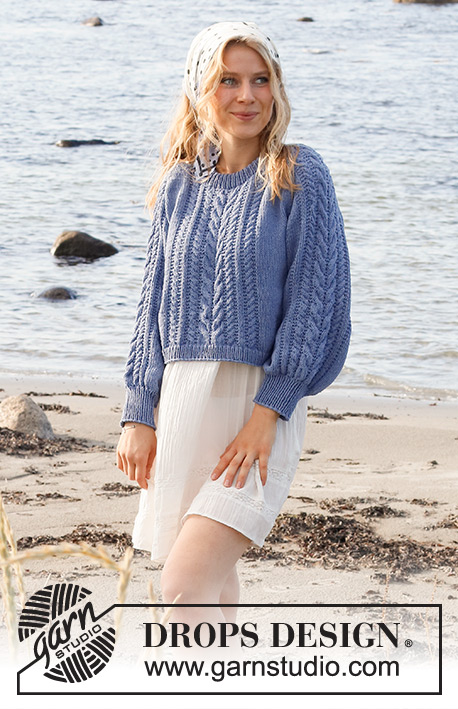 |
|||||||||||||||||||||||||||||||||
Knitted sweater in DROPS Merino Extra Fine. The piece is worked top down with saddle shoulders, double neck, cables and balloon sleeves. Sizes S - XXXL.
DROPS 221-12 |
||||||||||||||||||||||||||||||||||
|
------------------------------------------------------- EXPLANATIONS FOR THE PATTERN: ------------------------------------------------------- PATTERN: See diagrams A.1 to A.5. The diagrams show all rows in the pattern from the right side. Find your size in the diagram (applies to A.3). A.1 and A.2 are worked on the shoulders and sleeves. A.3 is worked on the front and back pieces. A.4 and A.5 are worked on the neck, if you choose Alternative-2. INCREASE/DECREASE TIP (evenly spaced): To work out how to increase/decrease evenly, count the total number of stitches on needle (e.g. 104 stitches), and divide by the number of increases/decreases to be made (e.g. 32) = 3.3. In this example, increase by making 1 yarn over after approx. each 3rd stitch. On the next row work the yarn overs twisted to avoid holes. When decreasing, work together approx. each 2nd and 3rd stitch. INCREASE TIP-1 (for shoulders, sleeves and yoke): FROM THE RIGHT SIDE. BEFORE MARKER: The new stitch twists to the right. Use the left needle to pick up the strand from behind between 2 stitches from the previous round/row, knit the front loop. AFTER MARKER: The new stitch twists to the left. Use the left needle to pick up the strand from front between 2 stitches from the previous round/row, knit the back loop. FROM THE WRONG SIDE: BEFORE MARKER: The new stitch twists to the right. Use the left needle to pick up the strand from front between 2 stitches from the previous round/row, purl the back loop. AFTER MARKER: The new stitch twists to the left. Use the left needle to pick up the strand from behind between 2 stitches from the previous round/row, purl the front loop. INCREASE TIP-2 (for sleeves): Work until there are 2 stitches left before the marker-thread, 1 yarn over, knit 4 (marker-thread sits between these 4 stitches), 1 yarn over. On the next round knit the yarn overs twisted to avoid holes. Then work the new stitches in stockinette stitch. DECREASE TIP (for sides of body): Work until there are 3 stitches left before the marker-thread, knit 2 together, work 2 stitches in stockinette stitch (marker-thread sits between these 2 stitches) slip 1 stitch as if to knit, knit 1 and pass the slipped stitch over the knitted stitch (= 2 stitches decreased). BINDING-OFF TIP: To avoid the bind-off edge being tight you can bind off with a larger size needle. If the edge is still tight, make 1 yarn over after approx. each 4th stitch at the same time as binding off; the yarn overs are bind off as normal stitches. ------------------------------------------------------- START THE PIECE HERE: ------------------------------------------------------- SWEATER – SHORT OVERVIEW OF THE PIECE: THERE ARE 2 ALTERNATIVES NECKS IN THE PATTERN. The sweater in the picture is worked bottom up, the sweater in the pattern-text is worked top down to give a neater fit for the neck/sleeves. ALTERNATIVE-1: This alternative has an easier neck to work. Start by working a double neck in the round, then continue in the round increasing for the saddle shoulders (the neck is the same front and back). When the increases for the shoulders are finished, increase for the sleeves and then the yoke. The yoke is divided for the body and sleeves; the body is continued in the round with circular needle. The sleeves are worked in the round with short circular needle/double pointed needles. ALTERNATIVE-2: This alternative has the neck shown in the picture. The piece is started back and forth, from mid-front, and stitches are cast on each side to form the neckline at the same time as stitches are increased for the saddle shoulders. When the increases for the shoulders are finished, increase for the sleeves and then the yoke. The yoke is divided for the body and sleeves and the body is continued in the round with circular needle. The sleeves are worked in the round with short circular needle/double pointed needles. When the sweater is finished, stitches are knitted up for the double neck. ------------------------------------------------------- ALTERNATIVE-1 – START HERE: DOUBLE NECK: Read SWEATER – SHORT OVERVIEW OF THE PIECE above. Cast on 104-108-112-116-120-124 stitches with short circular needle size 3.5 MM = US 4 and Merino Extra Fine. Work rib in the round (knit 1, purl 1) for 7 cm = 2¾". When the rib is finished, knit 1 round and increase 32-36-40-40-40-36 stitches evenly spaced– read INCREASE/DECREASE TIP = 136-144-152-156-160-160 stitches. Knit 1 round (yarn overs knitted twisted). Then work the yoke. YOKE – ALTERNATIVE-1: Change to circular needle size 4.5 MM = US 7. Insert 1 marker after the first 49-51-53-54-55-55 stitches (= mid-front) – the yoke is measured from this marker! In addition insert 4 new markers without working the stitches and each marker inserted between 2 stitches. These markers are used when increasing for the saddle shoulders and should have a different color from the marker mid-front. Marker-1: Insert before the first stitch on the round (= right back shoulder). Marker 2: Count 30 stitches from marker-1 (= shoulder), insert marker-2 before the next stitch. Marker 3: Count 38-42-46-48-50-50 stitches from marker-2 (= front piece), insert marker-3 before the next stitch. Marker 4: Count 30 stitches from marker-3 (= shoulder), insert marker-4 before the next stitch. There are 38-42-46-48-50-50 stitches left after marker-4 (= back piece). Allow these 4 markers to follow your work onwards. On the next round start the pattern and start increasing for the shoulders as described below. Read both sections before continuing! PATTERN – ALTERNATIVE-1: Work A.1 over the 30 shoulder stitches between markers 1 and 2 and between markers 3 and 4. Work A.3 over the 38-42-46-48-50-50 stitches on the front and back pieces (see marks in the diagram for your size). NOTE: As you increase for the shoulders, work the increased stitches on the front/back pieces into pattern A.3 until there is room for a complete repeat in width, then work new increased stitches in stockinette stitch (in XXL and XXXL work all the increased stitches in stockinette stitch as A.3 starts with a complete repeat). Continue this pattern. REMEMBER THE KNITTING GAUGE! A.1 is repeated in height until the increases for the shoulders are finished, A.3 is repeated in height to finished length. INCREASES FOR SADDLE SHOULDERS – ALTERNATIVE-1: AT THE SAME TIME, on the same round as the start of the pattern, increase 4 stitches for the shoulders as follows: Increase BEFORE markers 3 and 1, and AFTER markers 2 and 4 – read INCREASE TIP-1. You only increase on the front and back pieces; the number of shoulder stitches remains the same. Increase every round a total of 18 times in all sizes = 208-216-224-228-232-232 stitches. After the last increase the piece measures 7 cm = 2¾" in all sizes – measured from the marker mid-front. Go to SLEEVE INCREASES below. ------------------------------------------------------- ALTERNATIVE-2 – START HERE: YOKE: Read SWEATER – SHORT OVERVIEW OF THE PIECE above. Cast on 100-104-108-110-112-112 stitches with circular needle size 4.5 MM = US 7 and DROPS Merino Extra Fine. Insert 4 markers without working the stitches and each marker inserted between 2 stitches. These markers are used when increasing for the saddle shoulders. Marker-1: Insert after the first stitch (= left front of neck, when garment is worn). Marker 2: Count 30 stitches from marker-1 (= shoulder), insert marker-2 before the next stitch. Marker 3: Count 38-42-46-48-50-50 stitches from marker-2 (= back piece), insert marker-3 before the next stitch. Marker 4: Count 30 stitches from marker-3 (= shoulder), insert marker-4 before the next stitch. There is 1 stitch left after marker-4 (= right front of neck). Allow these 4 markers to follow your work onwards. On the first row start the pattern and start increasing for the shoulder. In addition, cast on stitches on each side for the neckline. Read all sections before continuing! PATTERN – ALTERNATIVE-2: Work A.4 over the first stitch (choose diagram for your size), A.1 over the 30 shoulder stitches between markers 1 and 2, A.3 over the 38-42-46-48-50-50 stitches on the back piece between markers 2 and 3 (see marks in the diagram for your size), work A.1 over the 30 shoulder stitches between markers 3 and 4, A.5 over the last stitch (choose diagram for your size). NOTE: As you increase for the shoulders, work the increased stitches on the front piece as shown into A.4 and A.5. On the back piece work the stitches into A.3 until there is room for a complete repeat in width, then work new increased stitches in stockinette stitch (in XXL and XXXL work all the increased stitches in stockinette stitch as A.3 starts with a complete repeat). Continue this pattern. REMEMBER THE KNITTING GAUGE! A.1 is repeated in height until the increases for the shoulders are finished, A.3 is repeated in height to finished length. When A.4 and A.5 are finished, work A.3 over these 50 pattern stitches (A.4/A.5 and the cast-on stitches mid-front) to finished length. INCREASES FOR SADDLE SHOULDERS – ALTERNATIVE-2: At the same time, on the first row (right side) increase 4 stitches for the shoulders as follows: From the right side, increase BEFORE markers 3 and 1, and AFTER markers 2 and 4 – read INCREASE TIP-1. From the wrong side, increase BEFORE markers 4 and 2, and AFTER markers 3 and 1. You only increase on the front and back pieces; the number of shoulder stitches remains the same. Continue like this, back and forth increasing on every row a total of 18 times in all sizes. NECKLINE – ALTERNATIVE-2: When you have worked 3 rows of pattern, cast on new stitches at the end of each row for the neckline (the first time stitches are cast on is at the end of the third row with pattern = right side). Cast on 1 stitch at the end of each row 4 times on each side, then 2 stitches at the end of each row 3 times on each side. At the end of row 17 (right side) cast on 16-20-24-26-28-28 stitches (mid-front of neck). Do not turn but work the last round in A.4/A.5 (= last increase for the saddle shoulders) over all stitches as follows: Work the last round in A.4, increase before marker-1, work A.1 as before over the next 30 stitches, increase after marker-2, work stockinette stitch and A.3 as before over the back piece between markers 2 and 3, increase before marker-3, work A.1 as before over the next 30 stitches, increase after marker-4, work the last round in A.5, then knit the 16-20-24-26-28-28 cast-on stitches mid-front. Cut the strand. There are 208-216-224-228-232-232 stitches and the piece measures 7 cm = 2¾" in all sizes – measured from the cast-on edge mid-back. Now begin the next round before marker-1. Go to SLEEVE INCREASES below. ------------------------------------------------------- ALTERNATIVE-1 AND ALTERNATIVE-2 CONTINUE FROM HERE FOLLOWING THE SAME PATTERN. SLEEVE INCREASES: Work pattern as follows: Work A.2 between markers 1 and 2 and between markers 3 and 4, work A.3 as before between markers 2 and 3 and between markers 4 and 1 (make sure you continue on the correct row in the diagrams), the other stitches are worked in stockinette stitch. AT THE SAME TIME on the first round increase 4 stitches for the sleeves as follows: Increase AFTER markers 1 and 3 and BEFORE markers 2 and 4 – remember INCREASE TIP-1. You only increase on the sleeves; the number of stitches on the front and back pieces remains the same. Work the increased stitches as shown in A.2. Increase every 2nd round a total of 2-2-2-2-2-3 times = 216-224-232-236-240-244 stitches. The piece measures approx. 9 cm = 3½" in all sizes – measured from marker (alternative-1), cast-on edge mid-back (alternative-2). Now increase for the yoke. YOKE INCREASES: Move the 4 markers so they sit in the outermost stitch on each side of the front and back pieces (not between 2 stitches). There are 34-34-34-34-34-36 stitches between the markers on each sleeve. On the next round increase 8 stitches for the yoke, increasing both before and after each marker-stitch – remember INCREASE TIP-1. You are now increasing on both the front and back pieces and on the sleeves. The increased stitches are worked in stockinette stitch on the front/back piece and in A.2 on the sleeves until there are 38 stitches in A.2, then further increases are worked in stockinette stitch. Increase like this every 2nd round a total of 13-15-17-21-24-27 times = 320-344-368-404-432-460 stitches. Continue without further increases until the piece measures 19-21-23-26-28-30 cm = 7½"-8¼"-9"-10¼"-11"-11¾" - measured from marker (alternative-1), cast-on edge mid-back (alternative-2). Now divide for the body and sleeves as follows: S, M, L and XL: Start the round 1-1-2-2 stitches before the first marker-stitch. XXL: Start the round just before the first marker-stitch. XXXL: Start the round 1 stitch after the first marker-stitch. ALL SIZES: Place the first 64-68-74-82-84-88 stitches on a thread for the sleeve, cast on 8-8-10-10-10-12 stitches (in side under sleeve), work 96-104-110-120-132-142 stitches as before, place the next 64-68-74-82-84-88 stitches on a thread for the sleeve, cast on 8-8-10-10-10-12 stitches (in side under sleeve), work 96-104-110-120-132-142 stitches as before. Cut the strand. The body and sleeves are finished separately. THE PIECE IS NOW MEASURED FROM HERE. BODY: = 208-224-240-260-284-308 stitches. Insert 1 marker-thread in the middle of the 8-8-10-10-10-12 cast-on stitches under each sleeve. Allow the threads to follow your work onwards; they are used when decreasing in the sides. Start the round by one marker-thread and continue in the round as before with A.3 over the middle 50 stitches on the front and back pieces and the other stitches in stockinette stitch. When the body measures 4 cm = 1½" from the division, decrease 1 stitch on each side of both marker-threads – read DECREASE TIP (= 4 stitches decreased). Decrease like this every 4 cm = 1½" a total of 3 times in each side = 196-212-228-248-272-296 stitches. Work until the body measures 16-16-16-15-15-15 cm = 6¼"-6¼"-6¼"-6"-6"-6" from the division. There is 3 cm = 1⅛" left to finished length – try the sweater on and work to desired length. Knit 1 round and increase 10-10-12-12-14-16 stitches evenly spaced – remember INCREASE/DECREASE TIP = 206-222-240-260-286-312 stitches. Change to circular needle size 3.5 MM = US 4. Work rib (knit 1, purl 1) for 3 cm = 1⅛". Bind off with knit over knit and purl over purl – read BINDING-OFF TIP! The sweater measures approx. 44-46-48-50-52-54 cm = 17¼"-18"-19"-19¾"-20½"-21¼" from the shoulder down. SLEEVES: Place the 64-68-74-82-84-88 stitches from the thread on the one side of the piece on short circular needle/double pointed needles size 4.5 MM = US 7 and knit up 1 stitch in each of the new stitches cast on under the sleeve = 72-76-84-92-94-100 stitches. Insert a marker-thread in the middle of the new stitches under the sleeve; allow the thread to follow your work onwards – it is used when increasing under the sleeve. Continue in the round with A.2 as before over the middle 38 stitches – the other stitches are worked in stockinette stitch. When the sleeve measures 3 cm = 1⅛" increase 2 stitches under the sleeve – read INCREASE TIP-2. Increase like this every 3 cm = 1⅛" a total of 5-5-4-4-3-3 times = 82-86-92-100-100-106 stitches. Continue working until the sleeve measures 33-31-30-27-26-24 cm = 13"-12¼"-11¾"-10⅝"-10¼"-9½" from the division (There is approx. 9 cm = 3½" left; try the sweater on and work to desired length). Knit 1 round and decrease 36-38-42-46-46-50 stitches evenly spaced = 46-48-50-54-54-56 stitches. Change to double pointed needles size 3.5 MM = US 4 and work rib (knit 1, purl 1) for 9 cm = 3½". Bind off with knit over knit and purl over purl - remember BINDING-OFF TIP. The sleeve measures approx. 42-40-39-36-35-33 cm = 16½"-15¾"-15¼"-14¼"-13¾"-13" from the division. Work the other sleeve in the same way. ------------------------------------------------------- DOUBLE NECK – ALTERNATIVE-1: Fold the neck double to the inside and sew down. To avoid the neck being tight and rolling outwards, it is important that the seam is elastic. DOUBLE NECK – ALTERNATIVE-2: Start mid-back and knit up from the right side 136-144-152-156-160-160 stitches around the neck with short circular needle size 3.5 MM = US 4. Work rib in the round (knit 1, purl 1). On the first round decrease the number of stitches to 104-108-112-116-120-124 stitches. When the neck measures 7 cm = 2¾", bind off a little loosely with knit over knit and purl over purl. Fold the neck double to the inside and sew down. To avoid the neck being tight and rolling outwards, it is important that the seam is elastic. |
||||||||||||||||||||||||||||||||||
Diagram explanations |
||||||||||||||||||||||||||||||||||
|
||||||||||||||||||||||||||||||||||
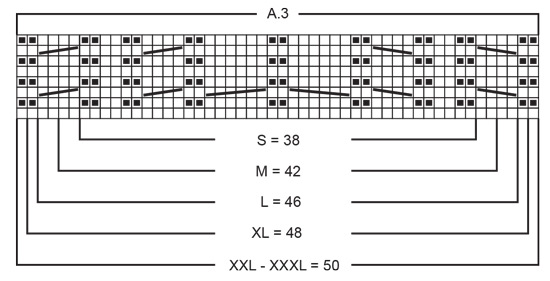 |
||||||||||||||||||||||||||||||||||
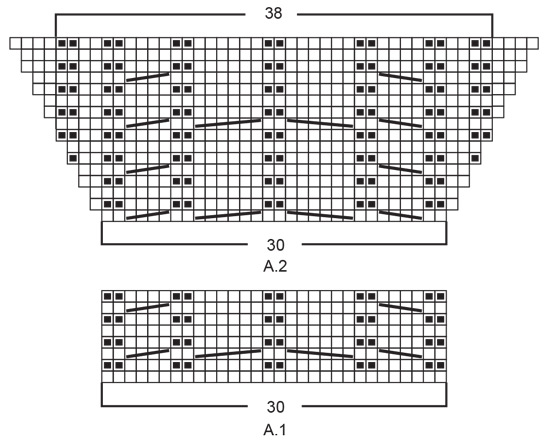 |
||||||||||||||||||||||||||||||||||
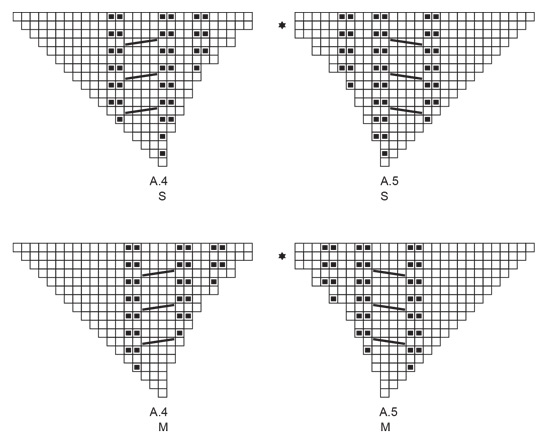 |
||||||||||||||||||||||||||||||||||
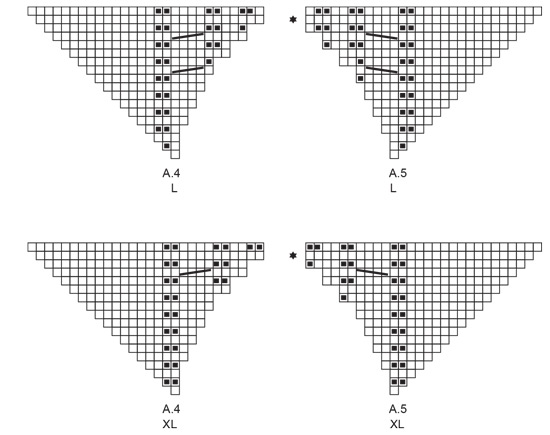 |
||||||||||||||||||||||||||||||||||
 |
||||||||||||||||||||||||||||||||||
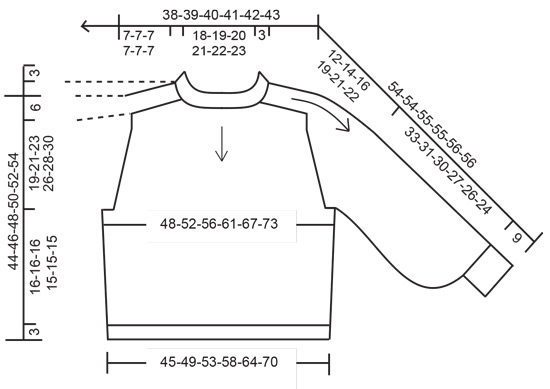 |
||||||||||||||||||||||||||||||||||
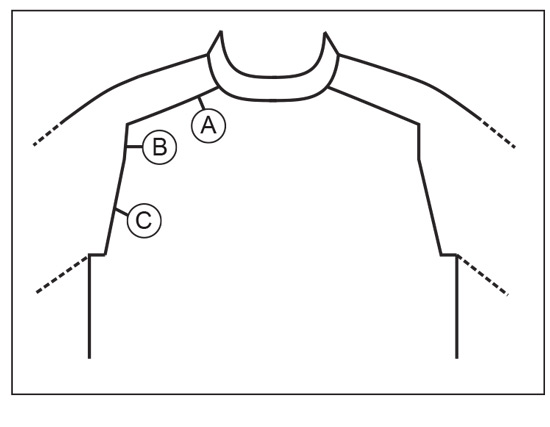 |
||||||||||||||||||||||||||||||||||
Have you finished this pattern?Tag your pictures with #dropspattern #sweptawaysweater or submit them to the #dropsfan gallery. Do you need help with this pattern?You'll find 30 tutorial videos, a Comments/Questions area and more by visiting the pattern on garnstudio.com. © 1982-2025 DROPS Design A/S. We reserve all rights. This document, including all its sub-sections, has copyrights. Read more about what you can do with our patterns at the bottom of each pattern on our site. |
||||||||||||||||||||||||||||||||||








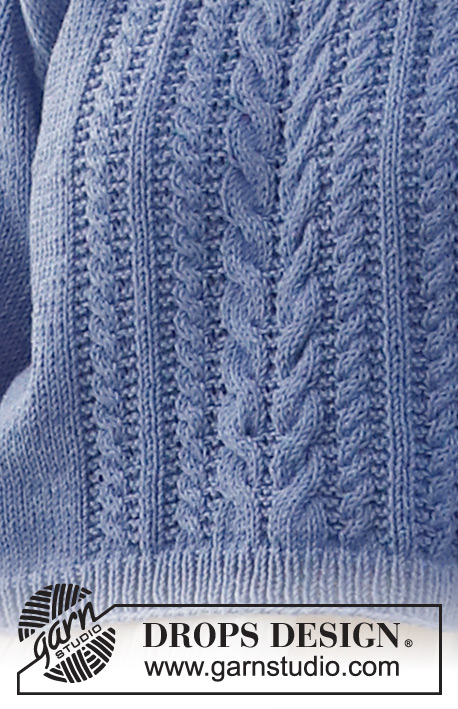

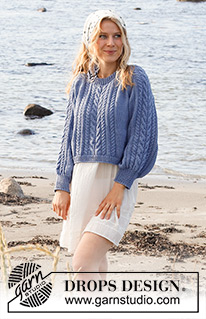
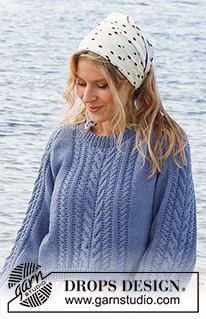
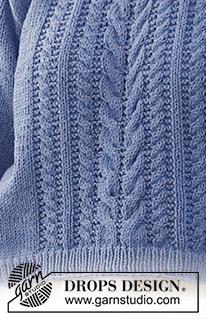
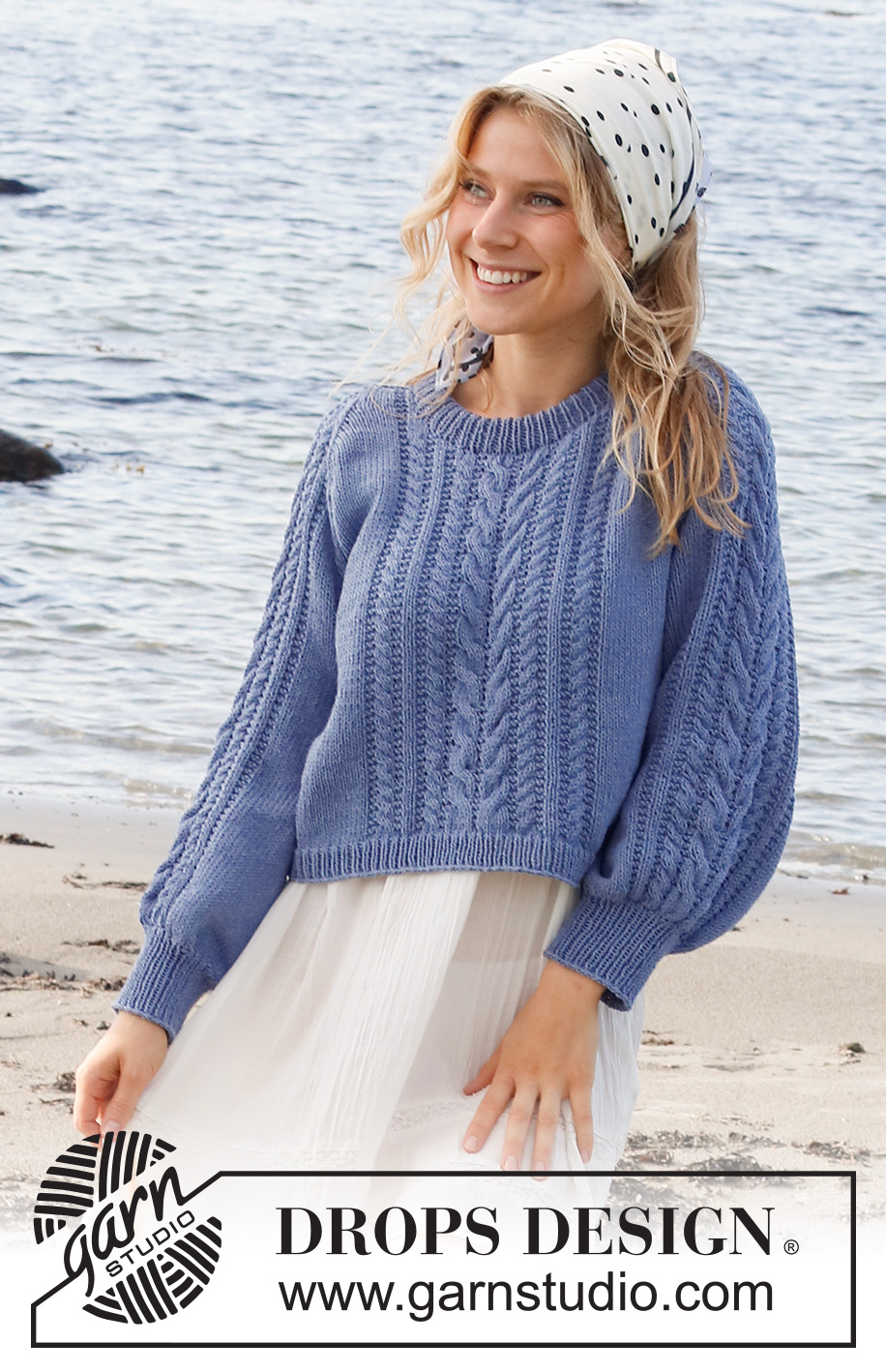
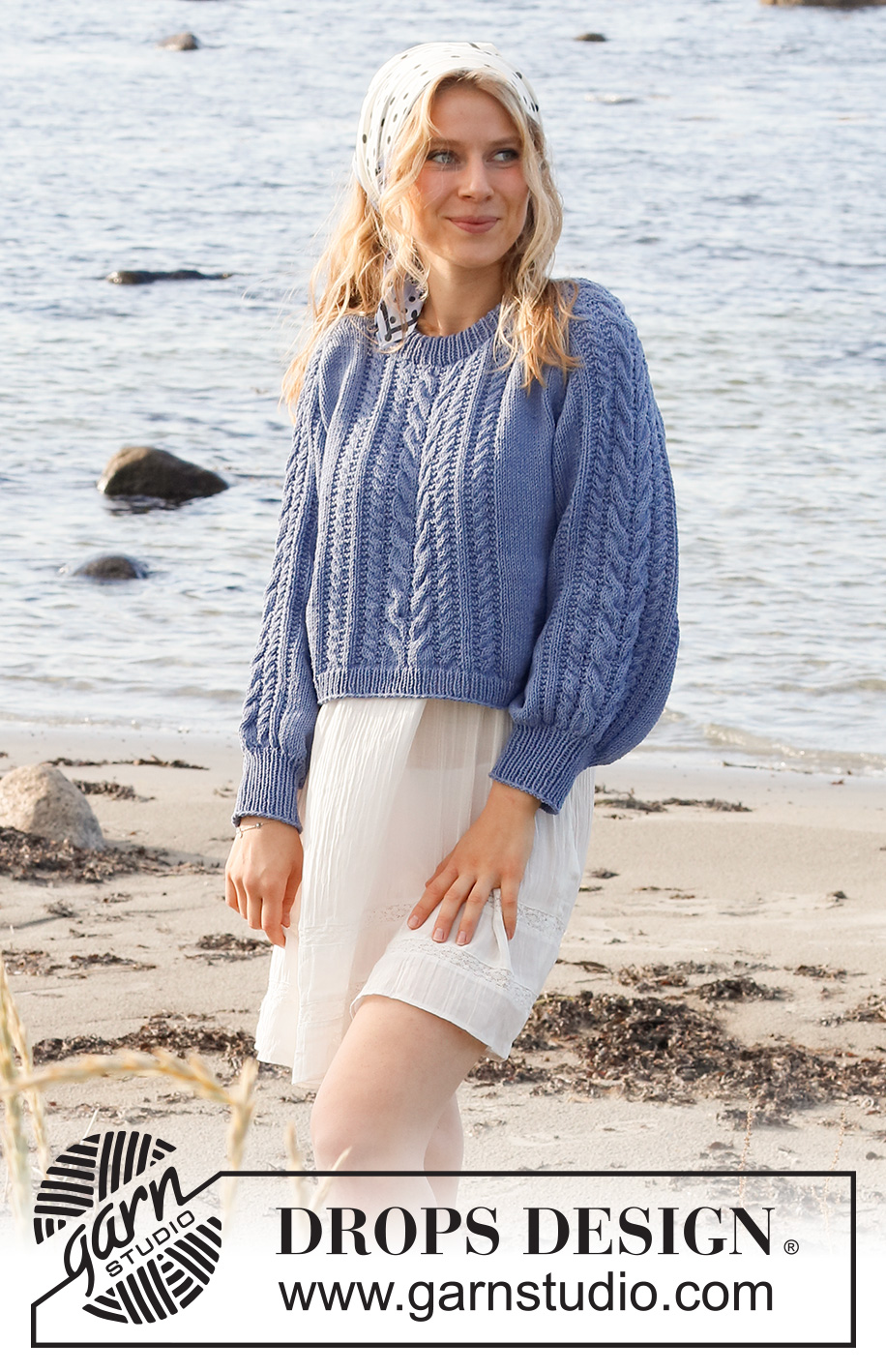
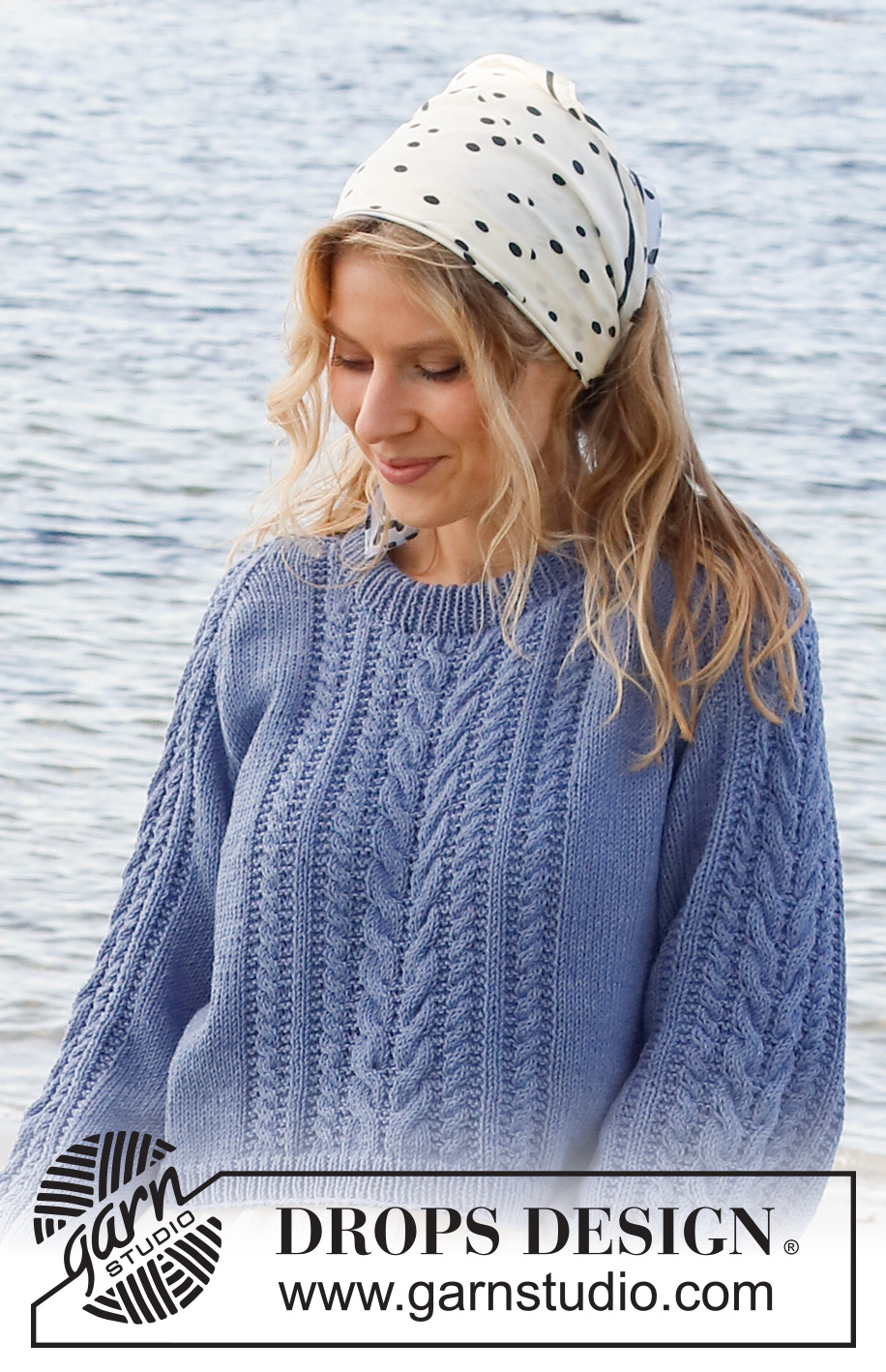
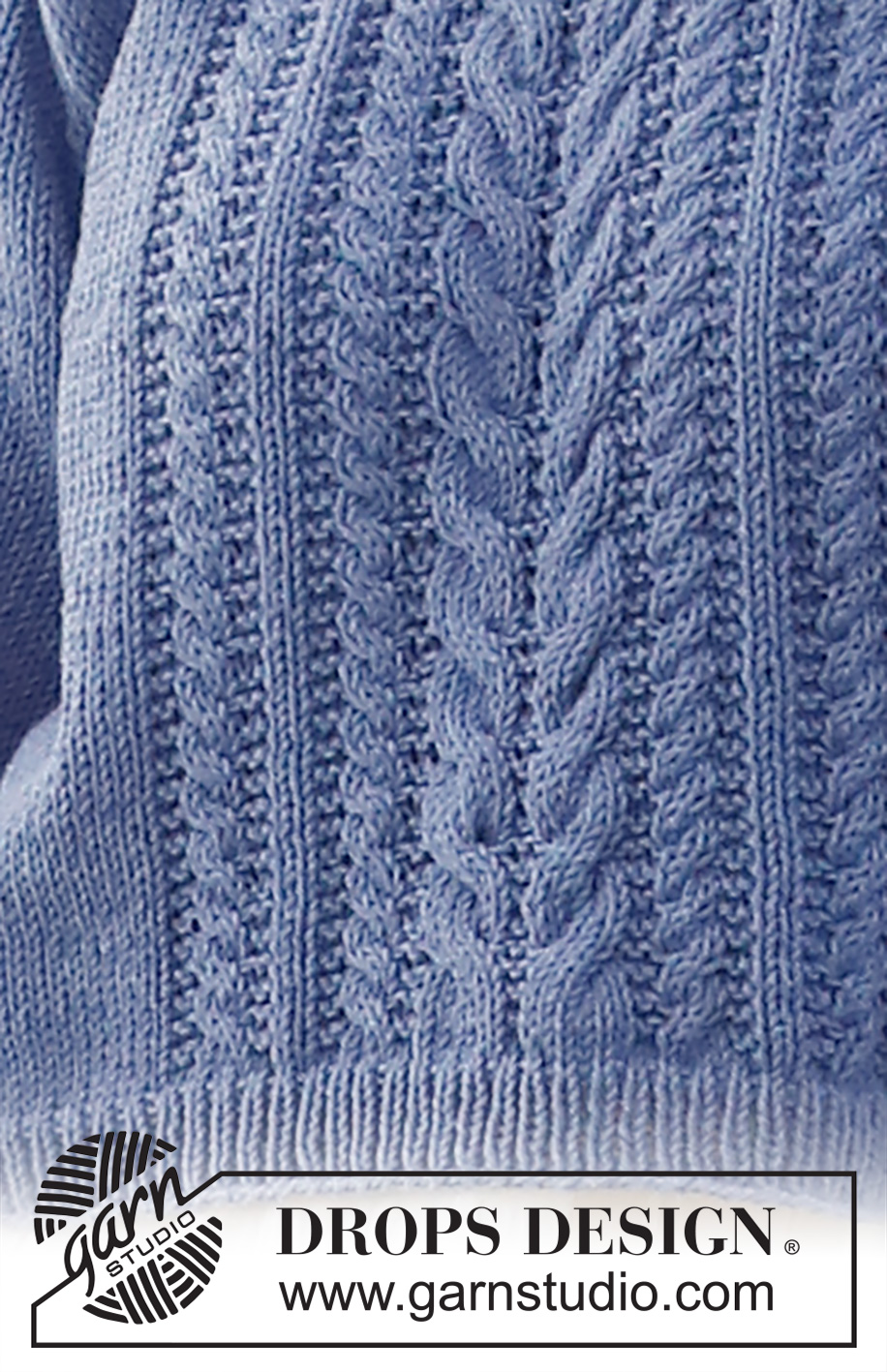


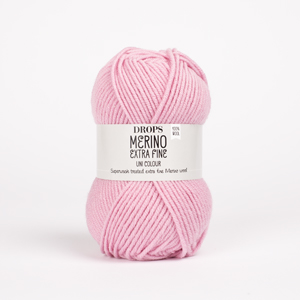
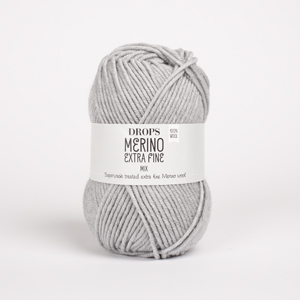

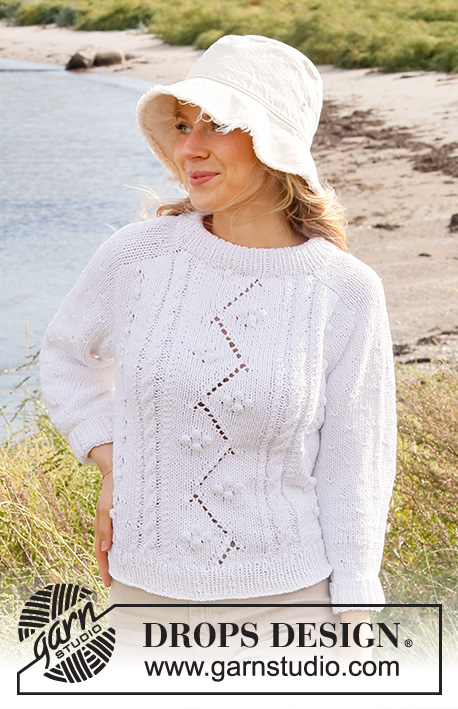





























































Post a comment to pattern DROPS 221-12
We would love to hear what you have to say about this pattern!
If you want to leave a question, please make sure you select the correct category in the form below, to speed up the answering process. Required fields are marked *.